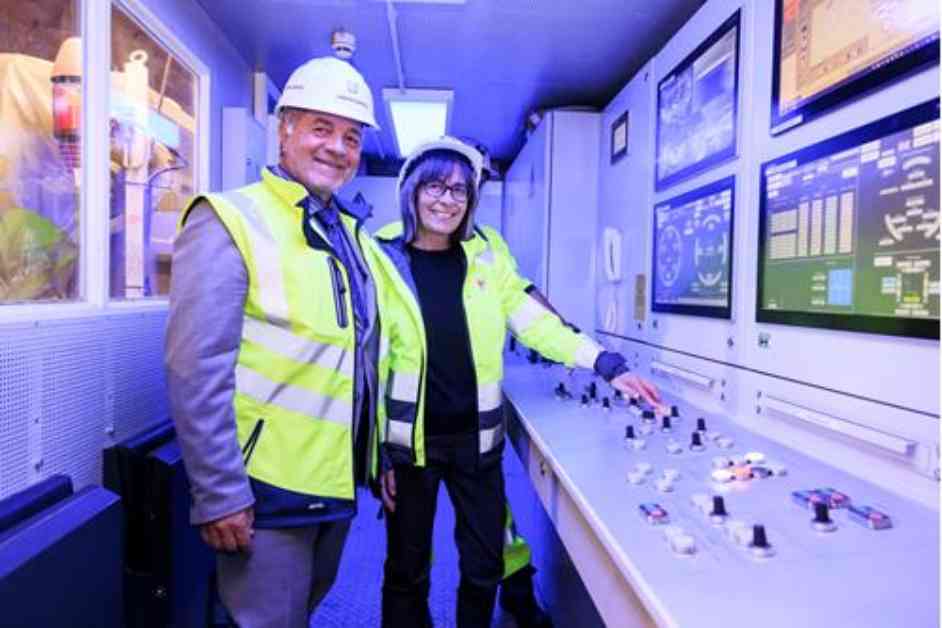Excitement as Tunnel Boring Machines „Olga“ and „Wilma“ Begin Operation
On September 18th, the two tunnel boring machines, named „Wilma“ and „Olga,“ were officially put into operation. These machines mark the final pair of nine tunnel boring machines being used in the construction of the Brenner Base Tunnel (BBT), which will consist of two 7.5 km main tunnels heading towards Innsbruck. „Wilma“ will bore the west tube, while „Olga“ will work on the east tube. The southward direction will see excavation done using the New Austrian Tunneling Method (NÖT).
The launch event at construction lot H53 Pfons-Brenner was attended by numerous dignitaries, including representatives from BBT-SE and the construction consortium (Porr Bau GmbH, Marti GmbH Austria, Marti Tunnel AG Switzerland). Martin Gradnitzer and Gilberto Cardola of the BBT Board expressed gratitude towards the dedicated team working tirelessly on both sides of the Brenner Pass. The European Climate, Infrastructure, and Environment Executive Agency (CINEA) has provided substantial financial support of €2.3 billion over 15 years for the BBT through the TEN-V and CEF-Transport programs. Paloma Aba Garrote emphasized that the BBT is a gift for future generations, contributing to an enhanced quality of life. Magda Kopczyńska, Director-General of the EU Directorate-General for Mobility and Transport (DG MOVE), echoed the EU’s commitment to backing the project.
Support for a Unified Europe Through Infrastructure
Philippe Chantraine of the EU’s DG MOVE, speaking on behalf of Coordinator Pat Cox, hailed the BBT as a symbol of a united Europe where regions, states, and the EU collaborate for the benefit of citizens. Tyrol’s Governor Anton Mattle sees the BBT not only as Europe’s largest railway project but also as a beacon of hope for citizens desiring a shift from road to rail freight transportation. Transnational cooperation in mobility and transportation is deemed crucial for a sustainable future by South Tyrol’s Governor Arno Kompatscher.
Judith Engel, Executive Director of ÖBB Infrastructure AG, shared that by late 2025, 130 kilometers of the new Koralmbahn line, including the 33 km Koralmtunnel, will be operational. The Semmering Base Tunnel is expected to commence operations in 2030, with the BBT set to become the centerpiece of trans-Alpine rail services by early 2032. Daniela Lezzi, Executive Director of Tunnel Ferroviario del Brennero (TFB), representing the Italian rail network operator RFI, expressed delight in witnessing the project’s progress. RFI is actively advancing the Franzensfeste-Verona railway line expansion, with a budget of around €3 billion, partially financed by the EU.
Sustainable Construction and Environmental Benefits
In addition to excavating the tunnels, the tunnel boring machines „Wilma“ and „Olga“ will also assemble the tunnel linings – known as Tübbinge – which serve as the tunnels‘ inner shells. Unlike in the neighboring construction lot H41 Sillschlucht-Pfons, space constraints at lot H53 Pfons-Brenner prevented on-site Tübbinge fabrication. However, by transporting the Tübbinge via rail, approximately 40,000 truck journeys can be avoided, thereby reducing environmental impact significantly.
The utilization of tunnel boring machines like „Olga“ and „Wilma“ not only expedites tunnel construction but also minimizes disruption to the surrounding environment. These machines are a testament to technological advancements in tunneling, ensuring the efficient completion of vital infrastructure projects such as the Brenner Base Tunnel. With the support of various stakeholders and funding bodies, the BBT is set to revolutionize cross-border rail connections, promoting sustainable transportation solutions in the heart of Europe.
As the BBT progresses towards completion, it stands as a symbol of cooperation, innovation, and environmental responsibility in the realm of infrastructure development. The dedication of the team behind the construction, coupled with the unwavering support of governmental and EU entities, underscores the significance of the project in shaping the future of European transportation networks.

